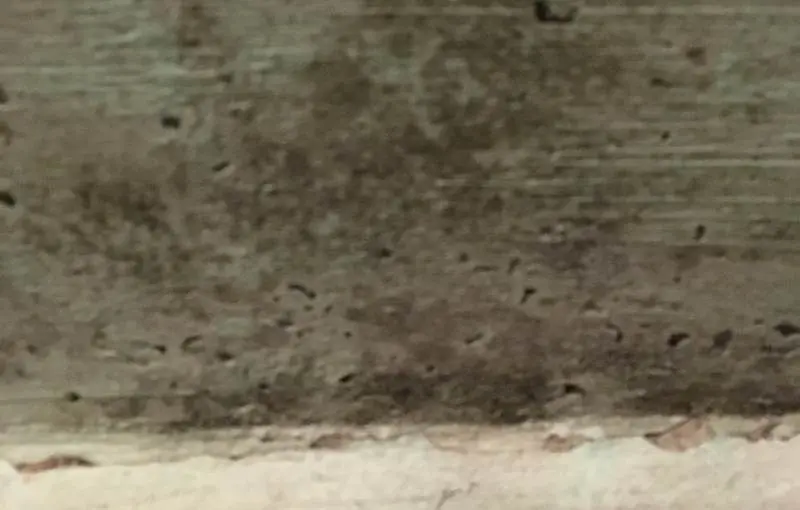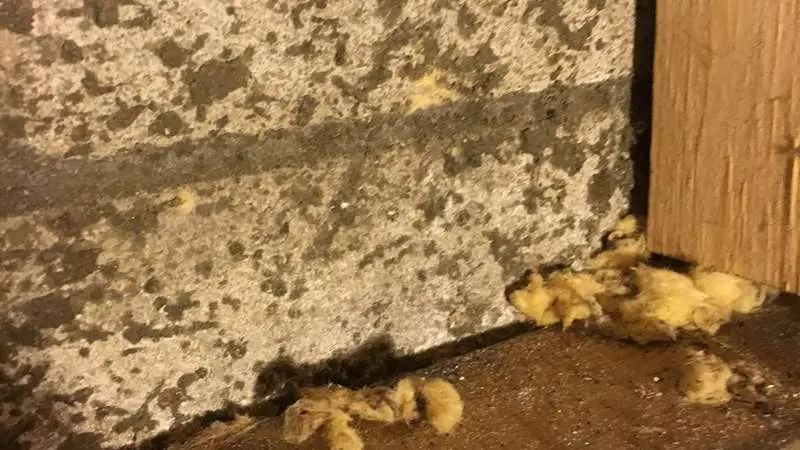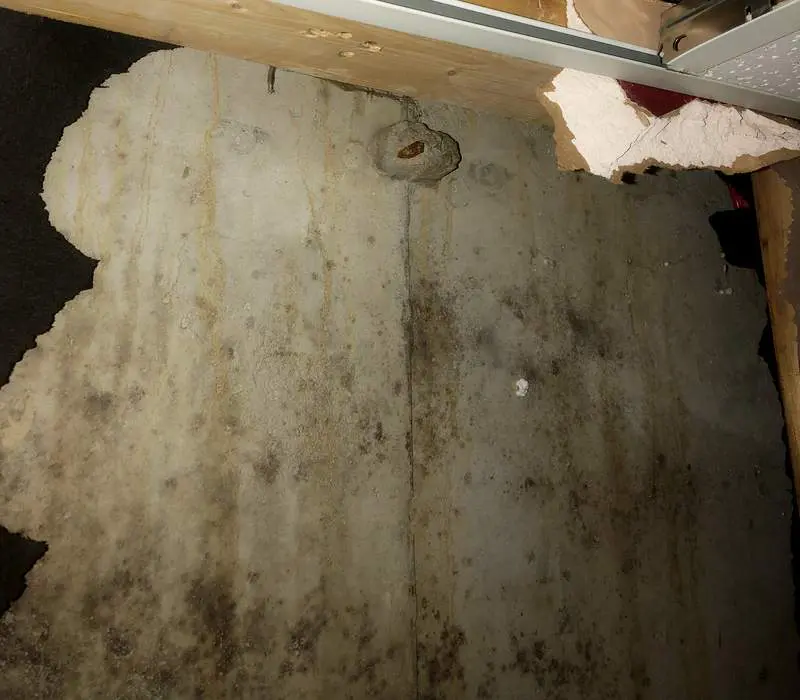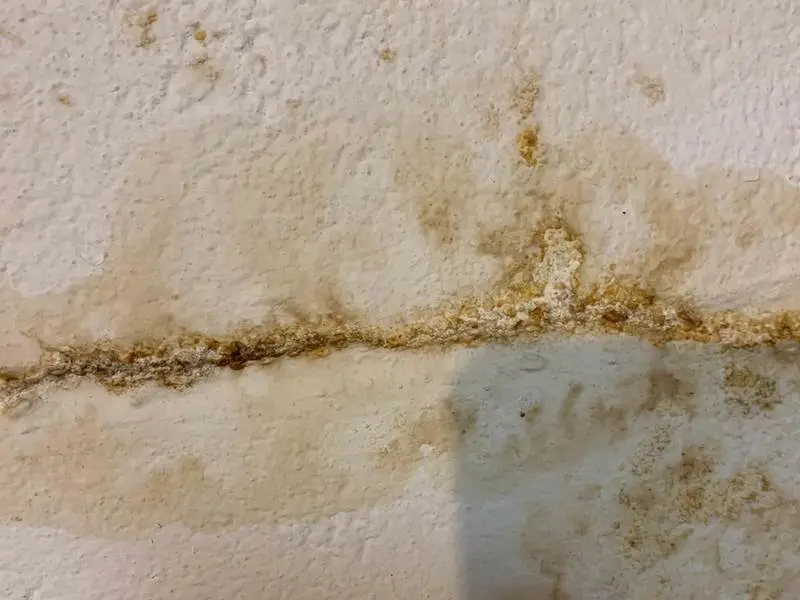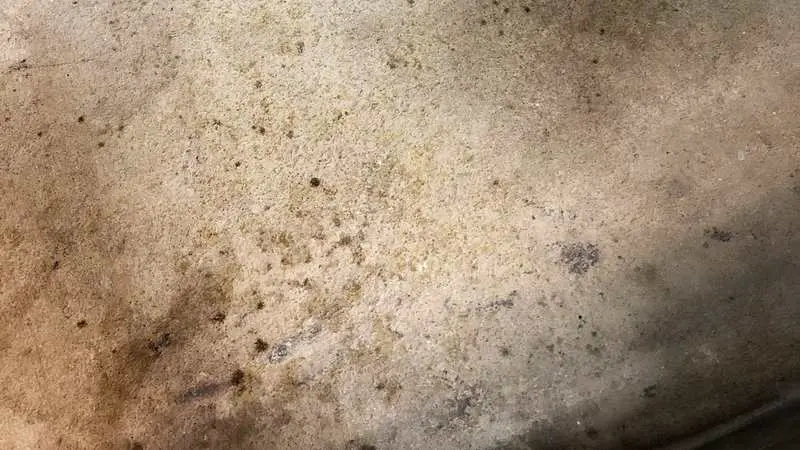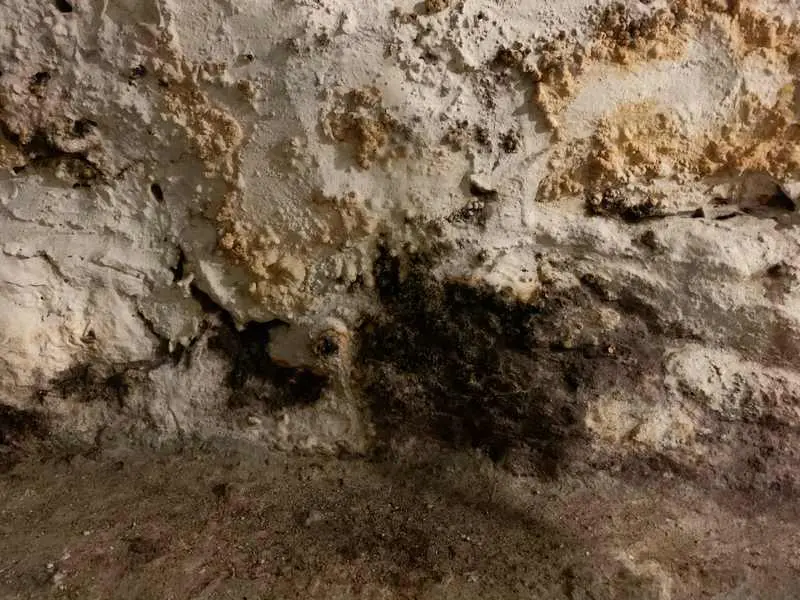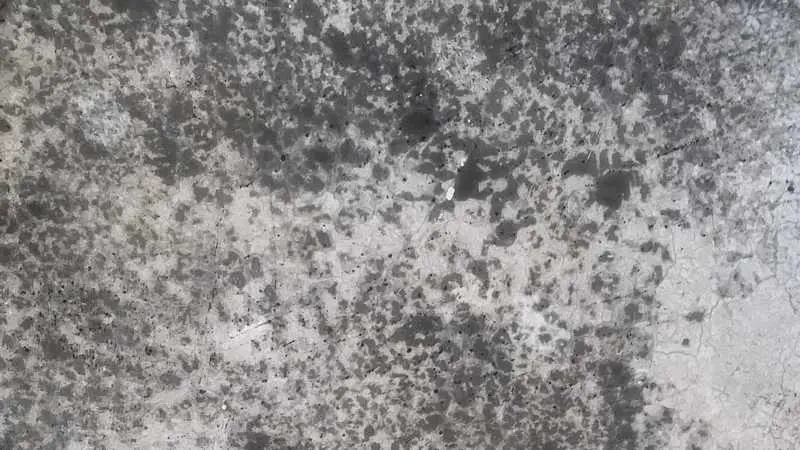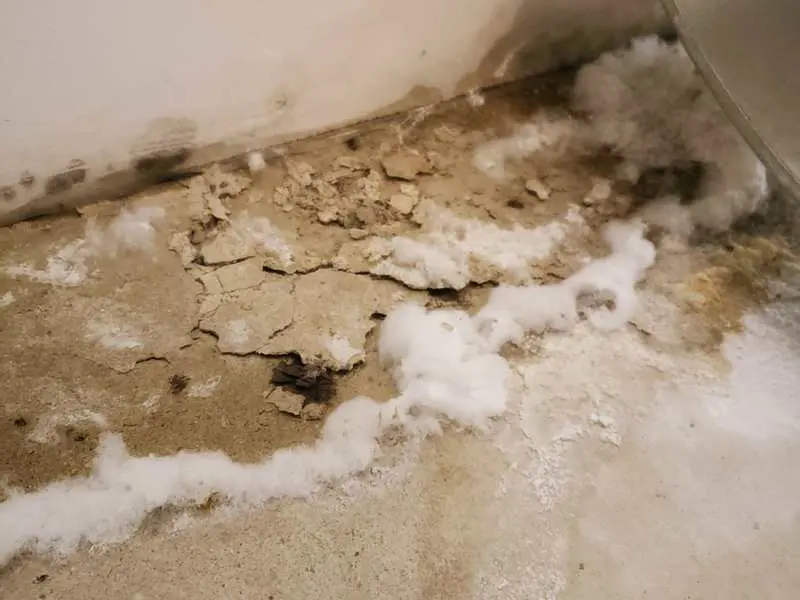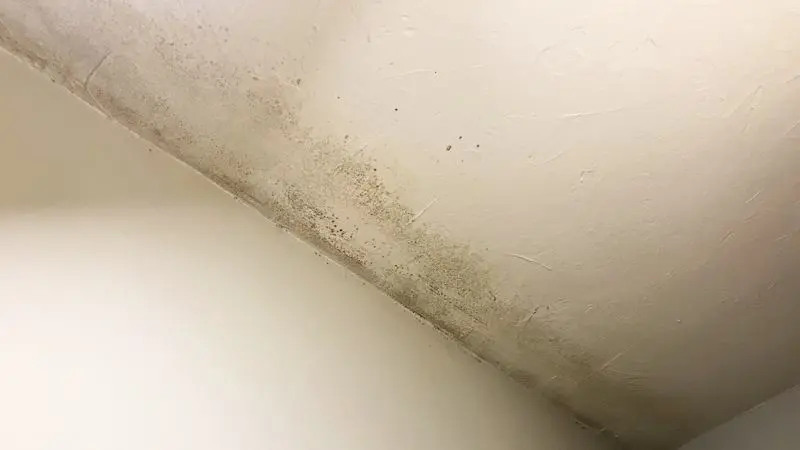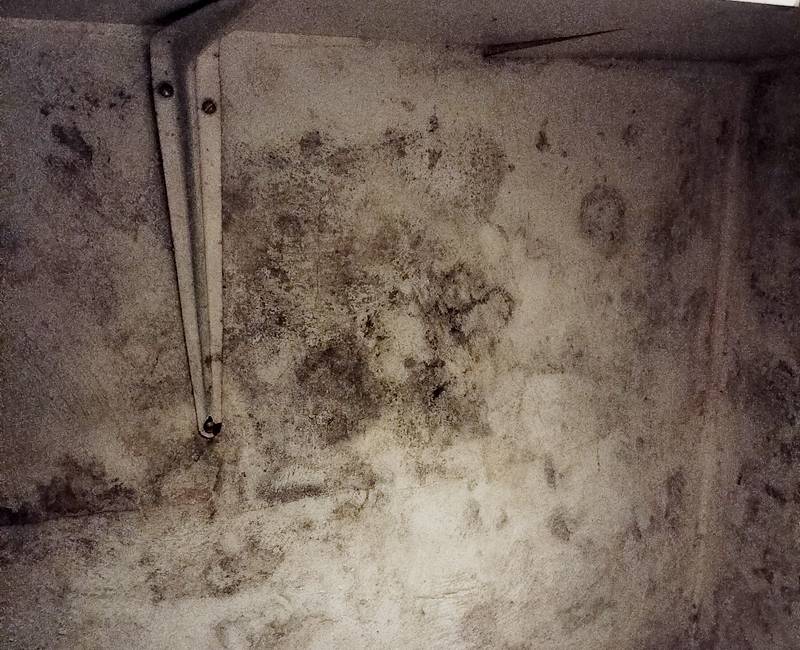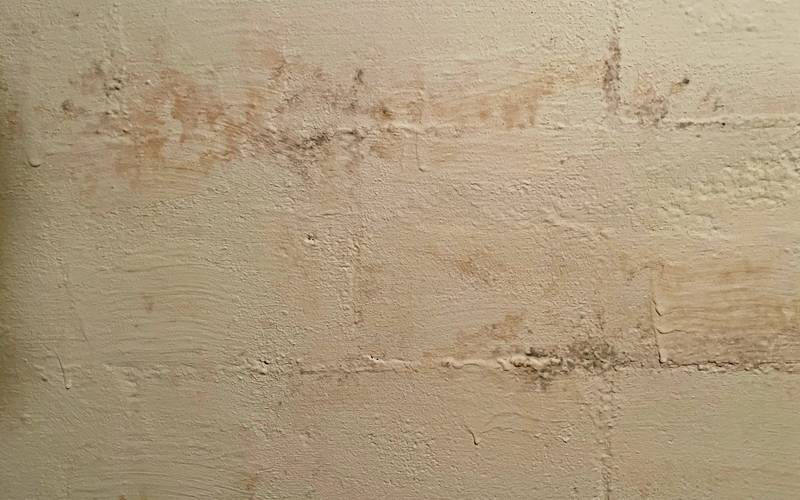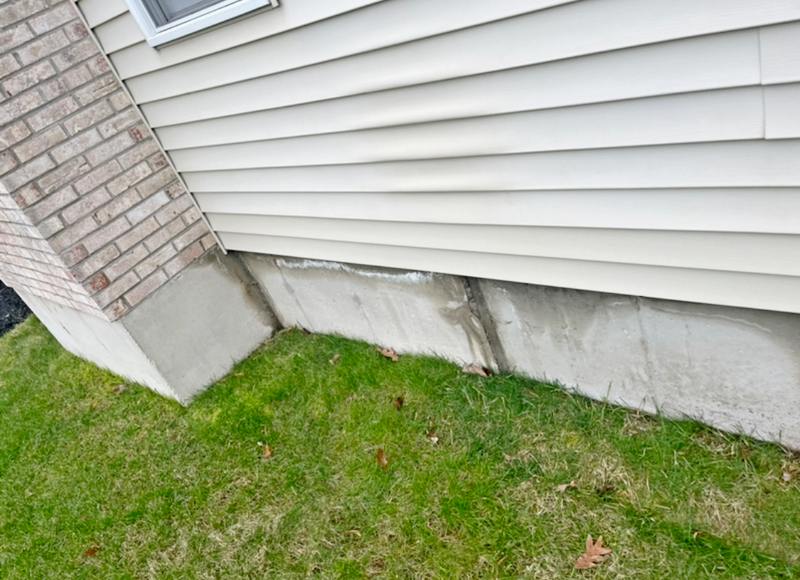Mold Growth on Concrete - How to Clean it and How to Prevent Regrowth
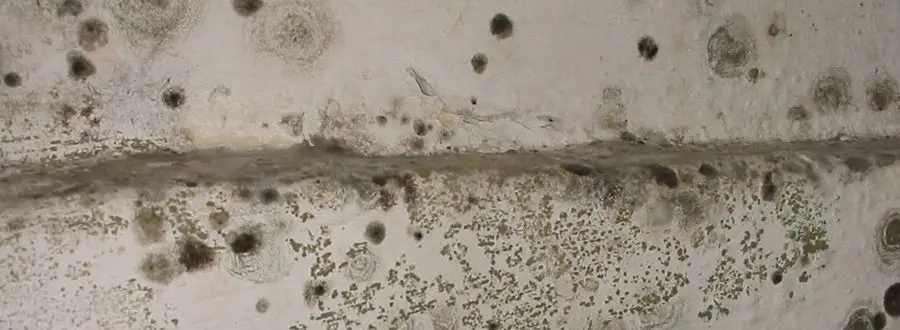
First, is it really mold growth?
Identifying mold growth on concrete can be a bit tricky. If it’s black mold growth, it is easy to identify. But if it’s white mold growth, things can get confusing. There are several similar looking substances that can fool you.
Efflorescence
Efflorescence can look very similar to white mold growth. It occurs when moisture moves through concrete (or other types of masonry) and pulls minerals along with the water. As the water evaporates at the surface, the salts and minerals are left behind, leaving a crystalline growth.
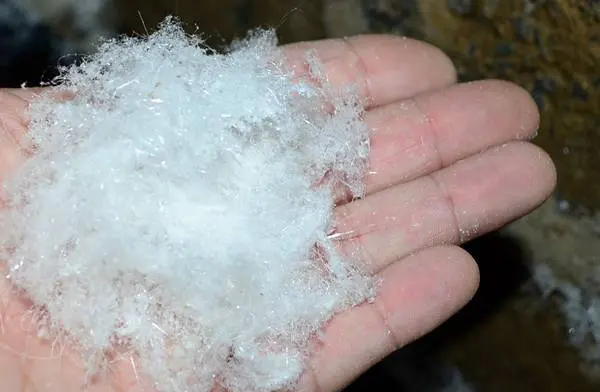
Mold or efflorescence? (it’s the latter)
Differentiating between mold and minerals is easy. Spray a small amount of water on the substance. If it dissolves away, it’s efflorescence. If it doesn’t, it’s likely mold growing in your basement.
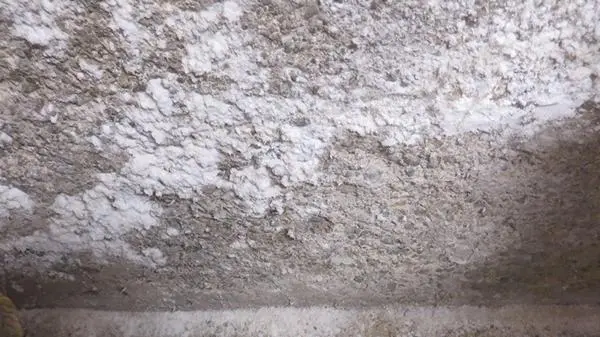
Looks like white mold, but it’s just mineral deposits.
Why does mold grow on concrete?
Moisture. This is the one variable we can control when dealing with mold. With concrete you have 3 primary avenues for excess moisture.
Liquid water intrusion
If any part of your home is below grade, you’ve essentially created a giant empty bowl surrounded by water. Without proper drainage and/or a sump pump, the water will eventually make it through the concrete. Large cracks or holes are not necessary. Hydrostatic pressure is quite powerful and can force large amounts of water through hairlines cracks. Liquid water intrusions certainly can cause mold growth, however it is usually quite localized.
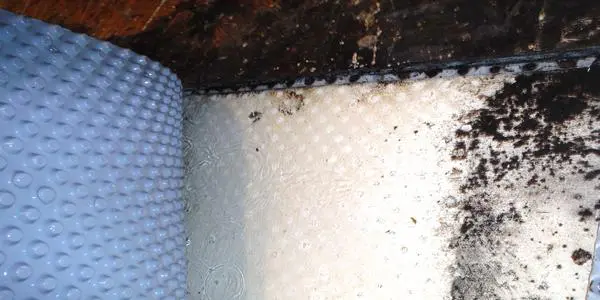
Mold growing on concrete beneath failed waterproofing
Humidity based mold growth
Concrete is a poor insulator. During the winter months when the temperature drops, the cool surface of a concrete wall can cause condensation. In time this elevated surface moisture creates an environment conducive to mold growth.
Mold growth on concrete due to humidity is typically diffuse and spread across a large area.
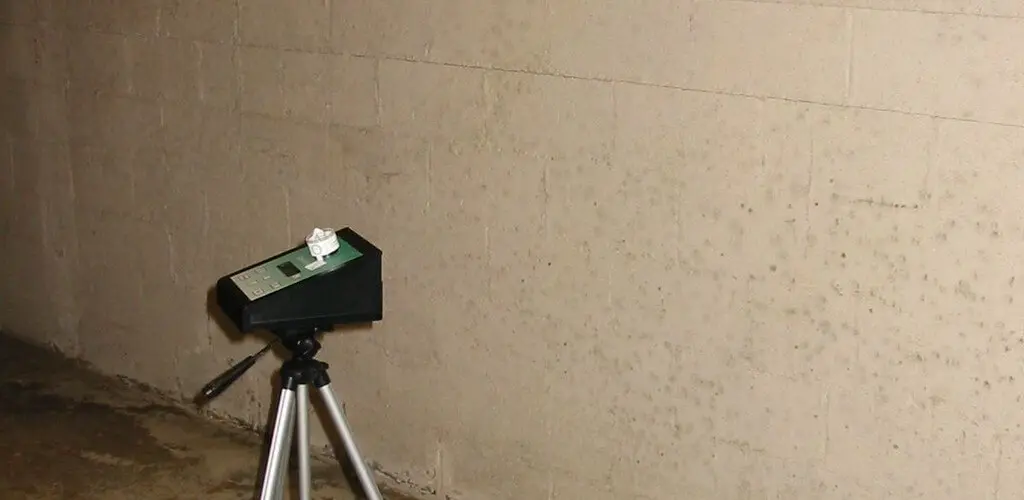
Mold growth on a concrete wall due to excess humidity.
On it’s own, concrete does not provide a sufficient food source for fungal growth. Unfortunately this is not especially helpful, because like almost anywhere in a building, dust quickly accumulates on the surface. Within this layer of dust large quantities of food sources for mold are present. Therefore, unless the concrete is kept extremely clean, mold growth can occur.
Of course, even if the concrete is covered in dust, mold will not grow without sufficient moisture. In most situations, controlling the moisture, rather than the dust, is far more desirable. This includes tackling both airborne moisture (lowering the humidity) and liquid moisture (flooding, vapor drive).
How do I remove mold from concrete?
Thankfully, because of the extreme durability of concrete, removing mold growth is a relatively simple process. Unlike sheet rock, framing or carpeting, you don’t need to worry about damaging the underlying material.
If it’s a large area, a professional should perform the remediation. They’ll setup containment and HEPA filtration to ensure the spores don’t spread throughout your home during the cleanup process. If the area is relatively small, you can likely tackle it yourself.
The removal process typically requires the use of both a fungicide and physical removal of the mold. The fungicide will deactivate and kill the mold spores, but staining and discoloration will likely remain. This is often addressed with HEPA vacuuming, scrubbing, steam cleaning, sandblasting, etc. In large commercial settings, dry ice blasting is occasionally used to remove mold from concrete.
A note about expectations
While cleaning the active growth from the concrete is relatively straightforward, some staining will often remain. This is especially true when dealing with black mold growth. The pigment left behind by the growth can be difficult to remove. It’s important to remember, this staining is not a health hazard, nor can it regrow. It’s simply a byproduct of the original growth. If the discoloration remains after the initial cleaning, paint the concrete with a stain blocking concrete primer.
Preventing mold regrowth
If the problem is related to ground water intrusion:
If at all possible, resolve the moisture issue before it hits your concrete wall. This may be as simple as redirecting downspouts away from the affected area or sloping the ground away from the wall. It’s cheap and certainly worth a try.
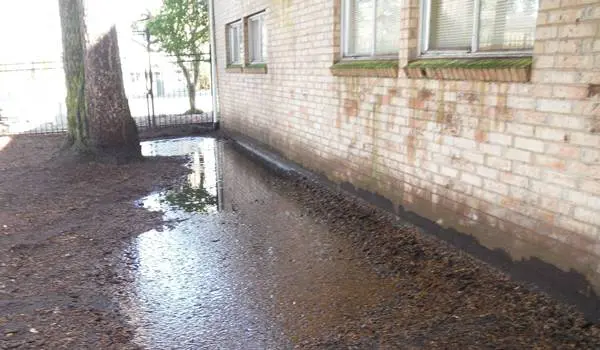
This is not helping their basement concrete mold issues…
If those techniques don’t solve the problem, you’re left with two choices – a french drain or interior footing drain. French drains are a great choice during the initial construction of the home or shortly thereafter. There’s little additional excavation because the foundation wall is already exposed.
Once a house is up and running, it’s a very different story. The excavation must deal with plants, trees, driveways, decks – basically anything within a few feet of the perimeter of your home. If it’s a single, unobstructed wall, it can be accomplished. But in many cases it’s cost prohibitive.
For existing homes, an interior footing drain is best. It’s the same concept of a french drain, but it’s installed inside the home, at the base of the concrete wall. In most cases, any framing directly against the wall must be removed first. If moisture is entering higher up the wall, dimple board will be necessary. This is a plastic membrane that directs the water downward toward the footing drain.
What about sealants?
In general, sealants and coatings are ineffective against basement water intrusion issues. If you have substantial water pressure from the outside, it will find a way in your home. They can be successful in scenarios where you have a single leak from an obvious crack.
If the mold problem is due to humidity:
Lower the relative humidity. Concrete is a poor insulator and therefore can become quite cool during the winter months. In a poorly ventilated basement, this can cause airborne moisture to condense on the surface and cause mold growth. There are three ways to reduce the RH in the area.
- Increase the temperature. The warmer the air in the room, the lower the RH. Now remember, if the temperature of the room increases, but the temperature of the concrete wall remains the same, the problem will remain. This is due to the dramatic increase in RH that occurs in the air immediately adjacent to the cold wall. However, in a fairly mild climate, the increased temperature of the air will sufficiently increase the temperature of the wall to prevent condensation from occurring.
- Improve the ventilation. Assuming the condensation occurs during the winter months, bringing in fresh air from the outside will reduce the RH inside the building. This is because warm air can hold much more moisture than warm air. So if we bring wet cold air into the home through ventilation, and heat it up, the net level of humidity will drop. It seems counter intuitive, but this can dramatically reduce the moisture load within the basement.
- Dehumidify. This isn’t our first choice, but occasionally it is the only option. There are a couple of reasons I don’t often recommend this technique. First, dehumidification requires a significant amount of electricity. Second, while it reduces the moisture in the air, it does nothing to improve the quality of the air. Musty odors, chemical fumes, VOCs, etc. will all remain in place if dehumidification is used. Alternatively, if the ventilation is improved, both the RH and the air quality will improve.
Case Study > Mold on Concrete in a Basement

Mold Growth in Basement
This project is a perfect example of the compounding factors of poor ventilation and uninsulated concrete walls. The RH in the basement was 80%. This is very high. Mold will begin growing on random contents at this level.
80% RH is problematic even in well insulated walls. In a room with concrete walls, it’s guaranteed to cause mold growth.
The solution?
Increase ventilation by installing a constant flow exhaust fan in the bathroom. These units replace a regular bath fan, but operate 24/7 at a reduced speed. They provide continuous ventilation throughout the day.
Project Notes
- RH: 80% Temp: 56 deg F. CO2 = 545 ppm CO = 0 ppm
- 15-18 inches of standing water was present throughout basement.
- Virtually every surface (wood paneled walls, ceiling, subfloor joists, concrete etc…) was covered with mold growth.
- All appliances were submerged and required removal.
- Sump Pump was present but was not running due to the power being cut off to the home.
- No ventilation to basement has trapped humidity and has allowed mold growth to occur on all surfaces.
- Mold growth was observed behind all ceiling panels on car-decking subfloor and ceiling joists.
*Heads up – I earn a small commission on sales through Amazon links. This helps cover the expense of running the website (and answering your questions!)
Got a question? Ask it here and we'll post the answer below
My basement leaked during heavy rain and a towel was left on the floor. Upon removing the towel, the floor was slimy and black. How do I clean it up?
Assuming the floor is concrete, spray the area with a Borax/water solution. Clean up the solution and any debris with paper towels.
Occasionally the mold growth will leave behind a stain, even after a vigorous cleaning. The staining is an aesthetic rather than a health issue. If this occurs, steam/pressure cleaning may be necessary.
My concrete mold is located on the front corner of step outside. It looks like harden yellow substance?
If it’s hard to the touch, it is likely efflorescence, not mold growth. Occasionally, efflorescence can appear in different colors (see photo above with orange deposits). This is due to an interaction of the minerals within the concrete.
Our basement cellar has a substance growing on it. Is this mold?
Yes, this looks like mold growth. It is quite common for cellars to suffer from mold growth. This is due to the cool temperatures and high humidity. Regularly cleaning the concrete can help (which admittedly is not a fun activity). Also, painting the concrete with semi-gloss, mold resistant paint will make it easier to clean. Depending on your climate, a long term solution might involve a dehumidifier or increased ventilation.
Picture of hard deposits (or growth?) on inside of concrete blocks. It's only on the lower 1-2 courses of block. Looks a bit like potential masonry cement spill but this doesn't feel plausible. Drywall just removed had black mold on the inside of the house surface. Insulation in block and drywall had little or no mold evidence. Should I have a sample taken and get the deposit tested?
This is a tricky one. If it’s hard to the touch, it’s not mold. It’s either mortar or efflorescence. The latter will dissolve in water. Typically it’s powdery, but I’ve seen it form hard, crystal like deposits in some cases. The fact you found mold on the backside of the sheet rock points to an ongoing moisture intrusion. This would explain the efflorescence, which occur when moisture moves through masonry. I recommend testing the deposits by submersing them in water. Do not reinstall the sheet rock until you’ve dealt with the underlying moisture issue.
I found a hard black coating under painted concrete in my basement. If after cleaning can I paint over it. It did not all scrub up. Does mold get imbedded in the cement.?
Based on your description, this does not sound like mold. On concrete, mold will appear in either a fuzzy format or a stain like appearance. It would not feel like a hard coating. In either scenario, it is fine to paint the concrete after you’ve thoroughly scrubbed and cleaned the area. Anything remaining is simply the pigment from the prior mold growth, which cannot regrow.
There has been a wet smell In our newly purchased home since we got here. The previous owners did not heat the home in the winter months and there is very poor ventilation in the basement. We removed some Gyproc today..does it look like we will have to remove it all?
Yes, the sheet rock should be removed. This is necessary not only to clean up the existing mold, but to implement the prevention measures.
First, you need to identify the source of the moisture. Three possibilities exist. 1.) Condensation from the warm interior air hitting the cold concrete wall. This typically does not happen behind a well sealed wall (i.e. sheet rock), but it’s possible.
2.) Vapor emissions through the concrete. This occurs when moisture moves through the concrete in vapor form, creating high humidity and saturation on the surface. In an uncovered wall, the water would simply evaporate into the air without causing an issue. The installation of the sheet rock traps the moisture, leading to mold growth. There are two solutions – either keep the concrete exposed or install dimple board with a interior footing drain.
3.) Liquid water intrusion. It’s possible you’re having liquid water enter through the cold joint at the bottom of the wall. If this is the case, you’ll see more damage at the bottom plate/framing than higher up the studs. In most cases, the solution is an interior footing drain.
We have a problem with a room in our basement. It is uninsulated and has a moldy smell. The odor is worse in the winter months. My son likes to sleep in the room - what should I do?
You’ll want to focus on two items – increasing the temperature and the air flow. Addressing these issues will lower the humidity and the mold growth/musty odor.
Purchase a relative humidity gauge and install it in the basement. Your goal is to keep the RH below 50%. Increase the heat as necessary to lower the RH until you’ve reached 50%.
The easiest way to increase the ventilation is to run a bathroom exhaust fan. If there’s an existing fan in the basement, run it at least 12 hours per day in the winter months.
It’s also important to verify whether the basement is suffering from vapor emissions through the concrete slab. This occurs when water vapor moves up through the slab and into the room above. If the basement is carpeted, the moisture can become trapped and lead to mold growth. See our page on basement mold for more info.
My basement wall has developed this in recent months. This is a shared wall of a twin home, but this part of the wall extends past the neighbor's house and I believe there is water sitting on the side of the house. Is this mold?
This is likely a combination of mold and efflorescence. Efflorescence occurs when moisture migrates through the concrete, picking up minerals along the way. Once the moisture reaches the surface, the water evaporates, leaving behind the mineral deposits. Because this is a product of water movement, often a small amount of mold growth is present as well. If the concrete wall is unfinished/uncovered, it will typically dry out on its own. However, you’ll need to fix the issue if you plan on finishing out this wall with framing, insulation, etc. The wall will inhibit dry out and lead to mold and rot damage to the framing.
Preventing moisture migration through a concrete foundation wall is accomplished by a combination of the following. 1.) redirecting downspouts away from the home. 2.) Installing a waterproof membrane on the interior side of the foundation wall. 3.) Installing an interior footing drain and sump pump at the base of the foundation wall.
We recently had a concrete shower installed 30-45 days, and these black spots have appeared. The shower does not properly drain, so water sits on the shower floor typically until we shower again. Is it mold?
Yes, this looks like light mold growth. While this may be aesthetically unpleasant, it’s not likely affecting the indoor air quality. Concrete can be surprisingly porous, depending on how it cured. This porosity allows water to penetrate and can lead to mold growth. Prevention is best achieved by treating the concrete with a penetrating sealer. Note – this should be done relatively soon, as the concrete loses its ability to absorb the sealant over time.
Is this mold? This is an old stone basement wall with either paint or drylock on the wall
The majority of this is efflorescence. The small area of black is likely mold growing on top of the salt deposits (efflorescence).
We just purchased our home three months ago and recently we discovered these discolored areas in our garage. Should we be worried? Should we be seeking some type of environmental remediation?
It’s difficult to determine from the photo whether this is mold or efflorescence. An easy way to distinguish between the two is by flicking a bit of water on the surface. Efflorescence will dissolve in water, mold will just mat down a bit.
Either way, it likely indicates vapor emissions moving through the concrete. You can verify this by taping a piece of plastic to the concrete. Recheck this in a few days. If you find condensation on the backside of the plastic, you have a vapor emissions issue.
In a garage this is not a problem, as long as you keep sensitive items off the floor. The vapor will eventually evaporate from the surface. Do not install carpeting on any concrete showing signs of vapor emissions! This will lead to major mold problems.
I have a major moisture issue along one wall in basement, particularly behind furnace duct.
The white, fluffy substance is efflorescence and the black spotting on the wall is mold growth. Efflorescence occurs when moisture moves through the concrete and deposits minerals/salts on the surface. In a basement, this can be a complex issue. First, I recommend looking at your downspouts and ensure they are moving the water far away from your home. Your goal is to reduce the moisture load in the soil near your home.
If this doesn’t solve the problem, you’ll likely need a sump pump and possibly an interior footing drain. While expensive, they are often the only way to completely solve the problem. In most cases this will involved removing the wall in the problem area so the footing drain can be installed at the very edge of the concrete slab.
Can mold grow beneath the new waterproof LVP floors on above grade concrete slabs?
This would be very unlikely. An above grade concrete slab would not suffer from vapor emissions or other ground water issues. The minimal air flow possible between the concrete and LVP would also limit any potential mold growth. Unless you have an active water leak, mold growth is not likely.
I live in a condo with concrete ceilings and a flat roof. I get mold along the exterior edge of my ceiling. What’s the best way to prevent this?
The simplest option is to increase the temperature and outside ventilation of this condo. Typically this is accomplished by running the bathroom exhaust fan 24/7. Our humidity page has an in-depth explanation of the approach. If you don’t have a working bathroom fan, you’ll have to find another way to introduce fresh air into the condo. Keeping a window cracked is an option, but can be uncomfortable during very cold weather.
My house was flooded from a broken water pipe resulting from a freeze. Is the white snow like substance on concrete mold, or the beginning of mold. And I've been putting rubber mats on the floor so that I don't have to walk on the huge amounts of dust from replacing drywall. Please tell me how I should be handling this situation. I"ve also been rnning fans thinking I was drying out the surface of concrete but I turned off the fans after reading the FEMA pamphlet.
White growth on concrete is nearly always efflorescence, not mold growth. You can verify this by spraying a bit of water on the suspected growth. If it’s efflorescence, it will disappear as the crystals are dissolved by the water. If it’s mold, it will flatten, but remain visible.
I recommend removing the rubber mats for now. The impervious nature of the mats will prevent the concrete from releasing the moisture. After a week or so, put a couple of mats back down. Peel them back a few days later and look for signs of moisture on the underside of the rubber. If you see moisture, pull them off and allow the concrete more time to dry.
Is this mold?
Yes, this is mold growth. I can’t tell from the photo whether this is truly concrete or sheet rock. Growth this heavy is mold likely on porous surfaces such as sheet rock, though it can occur on concrete. The intensity of the growth indicates a major moisture issue. I recommend contacting a basement/foundation waterproofing contractor to investigate the area. The area is suffering from either a water intrusion or extremely high humidity.
I’ve coated the concrete basement wall with Drylock and now it has this on it. What is it?
This looks like efflorescence, and possibly a small amount of mold growth as well. Concrete coatings will not stop vapor emissions and efflorescence. The force of the vapor is too much in most scenarios and overwhelms the coating. The vapor either causes the coating to fail (bubbling, delaminating, etc.) or it simply goes right through it.
I recommend not relying on a coating and instead looking at the cause of the vapor emissions. Begin with the outside of the home – redirect downspouts, divert rainwater, etc. You want as little water pressure on the concrete wall as possible. If this is insufficient, an interior footing drain with a wall membrane is the best solution.
You can also simply forego address the issue and keep the area well ventilated. The efflorescence isn’t a health issue and if it’s minor, you can ignore it. However, do NOT finish out this wall with insulation, drywall, etc. until you’ve completely stopped the issues. Once the moisture is locked in a wall cavity it will cause far more damage.
We had water damage from a leaking pipe that went from master bedroom to living room, garage and basement. It was behind the wall and continued to do damage for 2 months or so until visible damage was noticeable. Identified the cause and fixed it but the dry wall, insulation and walls below and around are drenched. Remediation team is on site. Due to the sustained and prolonged (2 months) water dispersion the concrete walls have been penetrated by water all the way to the outside concrete wall, where even parts of the siding of the house slightly buckled. I keep getting reassurance from the remediation company that this is fixable and all mold removed but is that even possible? When the damage is so substantial and has been building up for months now?
You’re correct – it appears the concrete is slowly releasing the water that accumulated during the leak. The vinyl siding is impermeable, so the moisture can only escape to the inside of the home. Depending on the season and climate, this often does not occur fast enough to prevent mold growth and other damage. Based on the buckling, the siding should be removed and the underlying sheathing replaced or dried.

